MONITORING OF CADMIUM CONTENT IN AGROECOSYSTEMS OF CENTRAL CHERNOZEM REGION OF RUSSIA
- 作者: Lukin S.V.1,2
-
隶属关系:
- Belgorod Center for Agrochemical Service
- Belgorod State National Research University
- 期: 卷 511, 编号 2 (2023)
- 页面: 274-279
- 栏目: GEOECOLOGY
- ##submission.dateSubmitted##: 30.01.2025
- ##submission.datePublished##: 01.08.2023
- URL: https://edgccjournal.org/2686-7397/article/view/649861
- DOI: https://doi.org/10.31857/S2686739723600704
- EDN: https://elibrary.ru/WGLDUJ
- ID: 649861
如何引用文章
详细
As part of the implementation of the state program of agroecological monitoring, the content of Cd in the main components of the agroecosystems of the forest-steppe zone of the Belgorod region, which is located in the south-west of the Central Black Earth region, was studied. The soil cover was mainly represented by leached and typical chernozems. During the studies, it was found that in the layer of 0–20 cm of arable black soil leached, the average gross content of Cd is 0.32, the concentration of mobile forms is 0.08 mg/kg, which corresponds to background values and significantly below the level of APC. The excess of background concentrations of this element was found in the soils of roadside ecosystems at a distance of up to 60 m from the roadbed. The main amount of Cd enters the agroecosystems of the Belgorod region with organic fertilizers, but this does not pose a danger to soil contamination and crop production. Of the crops studied, the minimum amount of this element is contained in the white lupine grain (0.011 mg/kg), and the maximum amount is contained in sunflower seeds (0.086 mg/kg). The average Cd content of corn, barley and winter wheat grains did not differ significantly and ranged from 0.037 to 0.042 mg/kg. In clover and alfalfa hay, the average content of this metal was almost the same as 0.012–0.013 mg/kg, which is significantly lower than in natural forbs (0.045 mg/kg). In the studied crop production, there was no excess of MAC Cd levels for food grains and MAL for feed.
作者简介
S. Lukin
Belgorod Center for Agrochemical Service; Belgorod State National Research University
编辑信件的主要联系方式.
Email: serg.lukin2010@yandex.ru
Russian, Belgorod; Russian, Belgorod
参考
- Медведев И.Ф., Деревягин С.С. Тяжелые металлы в экосистемах / Саратов: “Ракурс”, 2017. 178 с.
- Kabata-Pendias A. Trace Elements in Soils and Plants. 2011. 505 p.
- Виноградов А.П. Геохимия редких и рассеянных химических элементов в почвах. М.: изд-во АН СССР, 1957. 238 с.
- Шеуджен А.Х. Агробиогеохимия чернозема. Майкоп: ООО “Полиграф-ЮГ”, 2018. 308 с.
- Semenkov I.N., Koroleva T.V. International Environmental Legislation on the Content of Chemical Elements in Soils: Guidelines and Schemes // Eurasian Soil Science. 2019. V. 52, No 10. P. 1289–1297. https://doi.org/10.1134/S1064229319100107
- Chen Sh., Wang M., Li Sh., Zhao Zh., E W. Overview on current criteria for heavy metals and its hint for the revision of soil environmental quality standards in China // J. Integrative Agriculture. 2018. V. 17. № 4. P. 765–774.
- СанПиН 1.2.3685-21 “Гигиенические нормативы и требования к обеспечению безопасности и (или) безвредности для человека факторов среды обитания”. Утверждены Постановлением Главного государственного санитарного врача РФ от 28.01.2021 № 2.
- ТРТС015/2011 Технический регламент Таможенного союза “О безопасности зерна” (с изменениями на 15 сентября 2017 года) Технический регламент Таможенного союза от 09.12.2011 N015/2011. Режим доступа docs.cntd.ru›document/902320395 (дата обращения 03.02.2023).
- ВМДУ-87 “Временный максимально допустимый уровень содержания некоторых химических элементов и госсипола в кормах для сельскохозяйственных животных и кормовых добавках”. 1987.
- Lukin S.V., Selyukova S.V. Ecological Assessment of the Content of Cadmium in Soils and Crops in Southwestern Regions of the Central Chernozemic Zone, Russia // Eurasian Soil Science. 2018. V. 51. № 12. P. 1547–1553. https://doi.org/10.1134/S1064229318120074
- Методические указания по проведению комплексного мониторинга плодородия почв земель сельскохозяйственного назначения / В.Г. Сычев, А.Н. Аристархов, И.В. Володарская и др. М.: МСХ, 2003. 195 с.
- Методические указания по определению тяжелых металлов в почвах сельхозугодий и продукции растениеводства. М.: Типография Московской с.-х. академии им. К.А. Тимирязева, 1992. 61 с.
- Почвы Липецкой области / Ю.И. Сискевич, В.А. Никоноренков, О.В. Долгих и др. Липецк: Изд-во ООО “Позитив Л”, 2018. 209 с.
- Levels and Factors of the Accumulation of Metals and Metalloids in Roadside Soils, Road Dust, and Their PM10 Fraction in the Western Okrug of Moscow / D.V. Vlasov, O.V. Kukushkina, N.E. Kosheleva, N.S. Kasimov // Eurasian Soil Science. 2022. V. 55. № 5. P. 556–572. https://doi.org/10.1134/S1064229322050118
- Wang Q., Dong Y., Cui Y., Liu X. Instances of soil and crop heavy metals contamination in China // Soil Sediment Contam., 2001. V. 10. P. 497–510.
- Селюкова С.В. Экологическая оценка содержания свинца, кадмия, ртути и мышьяка в агроэкосистемах юго-западной части Центрально-Черноземного района России. Автореферат на соискание ученой степени кандидата биологических наук. М.: РГАУ–МСХА им. К.А. Тимирязева, 2019. 25 с.
- http: // www.fedstat.ru/indicators/stat.do (дата обращения 24.03.2023).
- Побилат А.Е., Волошин Е.И. Кадмий в почвах и растениях Средней Сибири // Микроэлементы в медицине. 2017. № 18 (3). С. 36–41.











